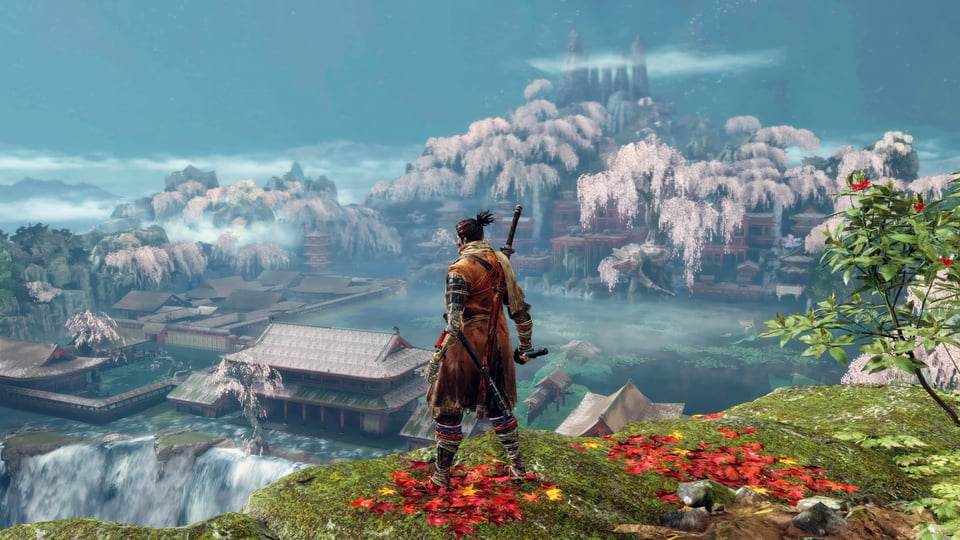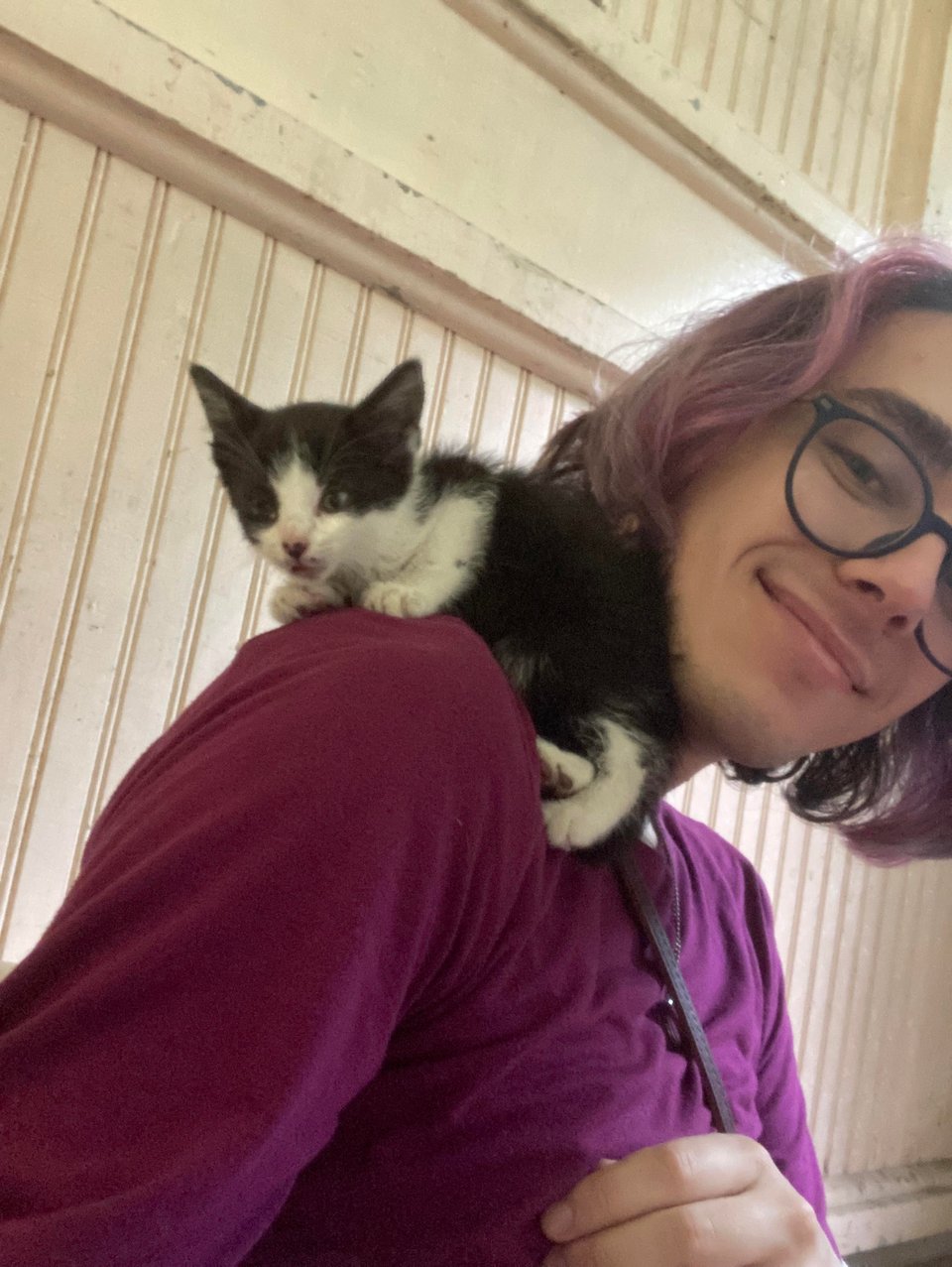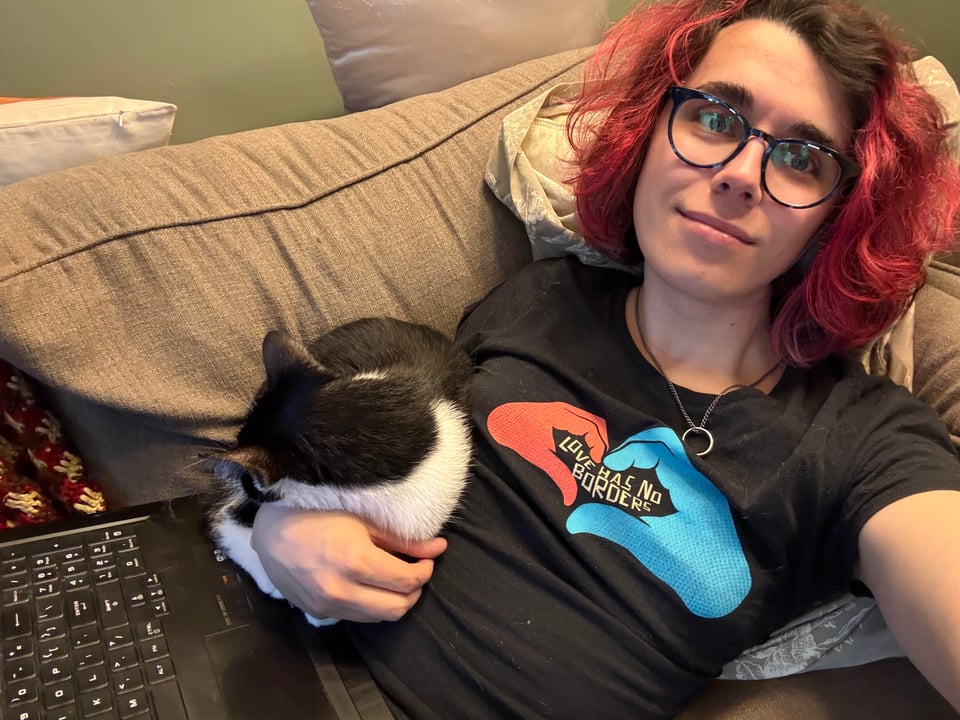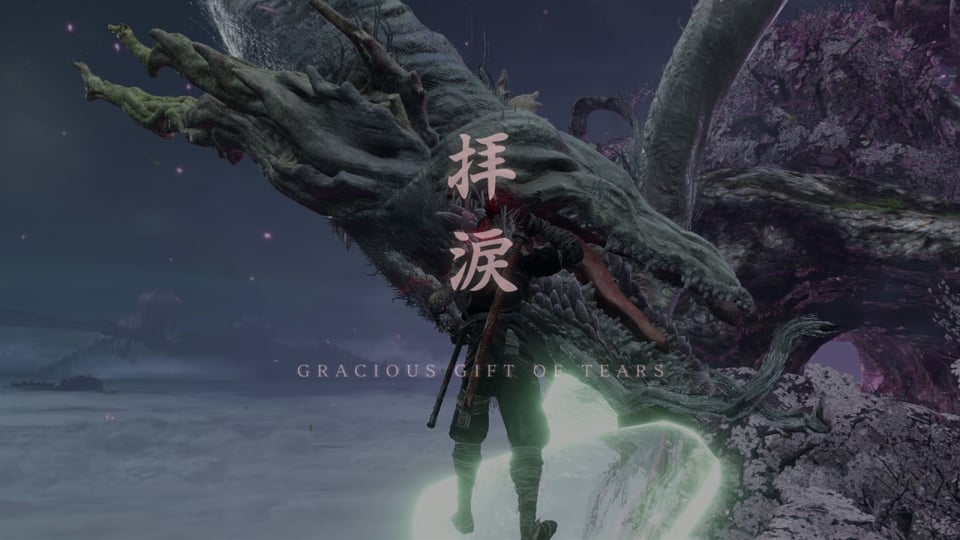The Gracious Gift of Tears
On the impossible
Sekiro: Shadows Die Twice is a 2019 character action game by developer FromSoftware, set in Sengoku-era Japan. You play as a recently one-armed shinobi by the name of Wolf, a man sworn to the service of a child named Kuro, who has the unfortunate heritage of divine blood within him; a divine blood that countless people will seek to get their hands on. Kuro has only shared his blood but once, to save Wolf from death several years prior to the event of the game, leaving him with a permanent side effect: he cannot die.
Set against the backdrop of the falling kingdom of Ashina, Sekiro explores Wolf’s struggle to protect Kuro against the political forces that seek to claim him for their cause, and against the devastating shadow of his adoptive father that hangs over the scars he carries. The game has many central mechanics, but the one that makes it into the title is perhaps the most important for this essay: due to Kuro’s intervention, Wolf is incapable of dying. Since this is a FromSoftware game, this does not mean he is incapable of suffering a case of death, merely that he will die… and get up again. And die. And get up again.
Kuro’s mid-game proposal to cut short the divine bloodline and save Wolf from the curse of immortality has been much meme’d: “How many times have you died for my sake? Two, three times?” at a point when the player’s death count is likely in the dozens (if not hundreds) is some rather humorous insult to injury on par with Devil May Cry 3’s “easy mode is now unlocked.” The game is, like all FromSoftware titles, about struggle, perseverance, and overcoming in the face of odds that feel impossible — and with Sekiro’s roster of bosses, the odds have never felt more insurmountable.
People have written and spoken a lot about how games like these can serve as outlets/coping mechanisms for depression due to how they help you persevere over challenges. I’ve already added my own to the ever-growing stack. Noah Gervais’ brilliant and incisive analysis of the Dark Souls trilogy and its successors in the modern FromSoftware catalogue explains better than just about anything how well their games can tap into the animal part of your brain: That isn’t just pixels on a screen, some tiny little character fighting the giant monster: in the conglomeration of sight and sound and haptic feedback, that becomes you who desperately dodges and unleashes a final blow against a towering monster.
One year ago, I started taking estrogen. It was a step that felt equal parts terrifying and essential. I had been hemming and hawing with myself for the past five years over what I was supposed to do with all these feelings of gendered agony that had been cropping up in my heart. Why did I cry myself to sleep after watching my first Contrapoints video? Why did all the times people “mistook” me for a woman while I masked during the pandemic make my heart stop?
For a long time I had been at best, loosely aware of the concept of transition. A vague conception of corrective surgeries, with no knowledge of the role/power of hormones. I sometimes wonder what different path my life would have taken if I had a better, more understanding perception of what transness was and could be. But that was then, and this is now. We’re moving forward no matter what.
Admitting to myself who I really was was one of the most terrifying things I’ve ever experienced in my life. How would my wife react? How would my family react? How would my life as an educator be shifted? Couldn’t non-binary be enough…?
One of the best elements of Sekiro is how it uses its mechanical struggle to reinforce the themes of the narrative, something that is not uncommon to FromSoft titles but one that is perhaps perfected here. Around 2/3rds of the way through the game, Wolf is presented with a choice: Side with his adoptive father Owl, who has been a specter of pain and trauma throughout the narrative up until this point, or break the shinobi’s Iron Code and stay loyal to Kuro.
The former choice sees Wolf fall to Shura, a demon overwhelming him and driving him to hate and kill indiscriminately, slaying his friend and doctor Emma, and Ashina’s leader Isshin. As the credits (unexpectedly) begin to roll, Kuro watches in horror as the flames of hatred and pain surround Wolf. This ending is horrible. It is also the easy way out, with a fairly manageable boss fight against Emma and Isshin. Betray your friends, betray yourself, and so the game ends as well. What hope is there for a Shura?
By contrast, if you decide to fight Owl, the game immediately kicks your teeth in. The old man taught Wolf everything he knows, and if you have used any of the shinobi’s bag of tricks up to this point, you will now find yourself on the receiving end. This fight is made all the more brutally difficult through Owl’s taunting of Wolf. We see how little regard he held for that child he found on the battlefield, his rage at the tool he crafted turning its blade on him. In rebelling against Owl, Wolf must turn against everything he has been raised to be. As if this wasn’t enough, the game has an entire final act to follow this, with a new brutal (and beautiful) area, and climaxing with the all-out siege and burning of Ashina. Not only is doing the right thing immediately challenged, but you have so much further to struggle.

When I first read about the effects of feminizing hormones, my heart must have stopped five or six times. Seeing trans women talk about the increased mental clarity, the joys of feeling emotions in a way that men are societally discouraged from now viscerally unlocked by the hormones, of smooth skin, of growing breasts, these things all overwhelmed me. Maybe I can be who I want to be. I would not call myself emotionally repressed in any way, I was often considered by the people in my friend group to be the #Sensitive one (even regularly being called the group mom in my friend groups a good 4 years before transness even entered the picture). But these things nonetheless seemed so impossible, even if I knew that I wanted them so badly.
A million what-ifs that I won’t bore you with occupied my brain, filled me with a physicalized anxiety that put an unpleasant strain on myself, my friends, and my marriage. How do you upend who you are? How do you turn back on everything you have been raised to be?
A tangential aside: As I write these paragraphs I am currently listening to the incredible “Tomorrow and Tomorrow” from Final Fantasy XIV, and idk, something about it just feels right. What a beautiful song. What a beautiful story. Chromatic basslines stay winning.
A honeymoon to Sicily where I had the opportunity to make a conscious choice: Present overwhelmingly feminine, as a then-non-binary person. See what a world looks like when people are (mostly) clocking you as a woman. When I came back I knew. I couldn’t be anyone else. I had to transition. That terrified me so viscerally I didn’t tell my family for a month. And the thing is? It was fine. The overwhelming concern from them was whether or not my wife and I still planned to stay together.
We recently celebrated the 10th anniversary of us dating. We had been married for just over a year when I told her that I was 100% certain I was trans. That was the most terrifying thing. I was so scared of jeopardizing our relationship, even if I knew that I had to be me, and that me looked a little different from how things had been for the majority of our time together. We’ve been through it all, long distance, chronic illness, and now transing of gender. At the end of the day, despite the terrors of the world around us, things are strong. We love each other dearly. The best things in life are worth fighting for.
Amazingly, just conquering the natural hurdles of Owl, the Fountainhead Palace, and the sacked kingdom of Ashina is not a guaranteed path to the game’s best ending. You need to go further. Eavesdropping on conversations as is a shinobi’s wont, piecing together the true nature of Kuro’s immortality. Finding and assisting another Divine child, this one artificially created by Buddhist monks who sought to break the wheel of Samsara rather than escape it. And confronting the most painful, repressed part of Wolf’s memories: When Owl stabbed him to death, causing Kuro to give of his blood and igniting the game’s entire raison d'être.
This specter of abuse and hatred that has haunted Wolf fights less dirty than the one we have already fought, but you will feel every one of those swings. You will die over and over, “No more than a stray after all…” muttered by Owl on each failure. In retrieving the magical macguffins set forth by the Divine Child, Kuro, and obtaining a sense of inner peace through confronting the memories of Owl, you can at long last make your way through the true ending.
When I sat there, vial of hormones in my hand, there was no hesitation. Surprising considering how much of the past decade of my life had been defined by that sort of hemming and hawing. But a loose echo spoken by the revived Isshin as you die to him over and over again made it the easiest choice in the world:
“Hesitation is defeat.” You cannot win if you hesitate in his fight. You cannot win if you hesitate in moving forward with what is right for your happiness.
One week after I injected my first dose of estrogen, our neighbor found a little kitten with a fucked up mouth in our driveway. Already having two cats, we said surely we could not take in another, but we’d foster the poor little guy.

We all agree looking back that of course we were gonna keep the little gremlin. But the rush of hormones I’d just injected that morning certainly had me feeling very motherly. I knew the minute I’d injected my first dose that I was setting on the right path for me. But there was something about this second one that cemented it in stone. I think lil’ Benny’s timing was pretty excellent.

It seemed so impossible, that some little chemicals could do what they’ve done to me. I am happier. More functional. My skin is smooth. My face has softened. I have boobs! But at the end of the day, it’s that sense that I have fully unlocked joy. This isn’t to say that there weren’t days I’d felt it before estrogen (adopting our other cat Addie with Bella, getting married, trying caldo freddo for the first time in Sicily), but it’s like there’s a z-axis to joy now, a depth to the canvas that wasn’t entirely there before. I get to be happy, and I get to do it in a body that is, day by day, just a little bit more me every time I wake up.
A few months after starting hormones, I watched I Saw the TV Glow, a devastating film about the pain of being trapped in the closet as a trans woman, unable to admit to yourself the truth of who you need to be. Having lived that pain for the past few years and only recently escaped it… I sobbed. You can be more. Please. You can get out of this psychic hell you live in.
Wolf has few friends in Sekiro — Emma is a faithful doctor, but remains largely wary of Wolf until he slays Owl and proves himself capable of pushing past Shura. But the first one we meet is the Sculptor, a former shinobi who carves Buddhas every day. He too, is one-armed, having been stopped in his tracks by Isshin Ashina before he could fall to Shura. But the flames of hatred still smolder within him, and when Ashina burns in the game’s climax, so too does he.
The Demon of Hatred is, for some, the hardest fight in Sekiro. It is a foe that defies all reason, it pushes the combat to its limits. The only way you can gain even a slight advantage against what has become of the Sculptor is to use a magical whistle, once used as a signal by his partner, a woman named Kingfisher. The demon writhes in agony, giving you time to make a few desperate hits without fear of reprisal. The onslaught is overwhelming and devastating, the demon’s 3 healthbars requiring your utmost for upwards of 5 minutes straight. One of the most horrifying moments in all of FromSoftware’s history must surely be piecing together that the destruction of Ashina is not merely the responsibility of the invading forces, but by this monstrosity that was once the closest thing you had to a friend in this world.
Wolf must leave his friend behind, grant him peace through death. As the final deathblow appears, the Sculptor cries out: “Finish me… Wolf… thank you…”. If we had taken the easy way out, that path or worse awaited us. Sekiro is a game about overcoming spiritual malaise, overcoming stagnation, about attempting to attain perfection.The difficult thing about perfection is that it is, of course, unattainable. I have no vision of what my perfect womanhood will be, but I know that I have something. That I am on my path to it. The choice seemed impossible, but it was also the only right one. The only just one.
Before the Demon of Hatred and the sacking of Ashina, before the game’s final boss, we ascend to a realm of the Divine in Sekiro. That boss is the source of this essay. The Divine Dragon is somewhat surprising mechanically: It is a gimmick fight that does not end in one of the game’s classic “Shinobi Execution” screens. Instead, we fight to subdue the dragon, a beast that has many interesting parallels to Wolf. It has been stabbed through the chest, and is missing the same left arm that was removed from us in the game’s tutorial.
When at last the dragon has been subdued… Wolf unlocks the vital ingredient to helping Kuro end the plague of immortality: The Gracious Gift of Tears.

I cry a lot now. I cried when I heard “Tomorrow and Tomorrow” while writing this, I cried when Benny came up and cuddled right as I was getting to the story about when he was a scrungly little gremlin who we immediately foster-failed. I was not immune to tears before estrogen, but they flow freely and often joyfully in a way that simply did not happen back then. I feel things so strongly that open weeping just seems like a vital fact of existence. These tears come from me, from my feeling feelings more strongly than ever before, from feeling them as me, with no layers of disconnect.
Wolf is a broken man at Sekiro’s beginning. Throughout much of it, he remains coarse and stoic, but he slowly regains both mental and physical composure. In the choice of endings that reward a player for persevering through all the game has to offer, he may choose to kill Kuro and end the divine lineage once and for all, offer himself in Kuro’s sake, or help to ferry Kuro’s soul to the east along with the Divine Child, to confront the roots of immortality. Magical gobbledegook these all may be to someone who hasn’t played the game, but what is so interesting to me is Wolf’s reaction to these choices.
The first two are more binary: Wolf hesitates, then steels himself. Kuro has asked for this, and it must be done. But after he hangs up his prosthetic arm, he takes the place of the Sculptor, carving Buddhas in the hopes of staving off the pain. Nothing was fixed in this ending, a brute force, default solution to the story, with the cycle at risk of continuing once again. If we choose for him to be the sacrifice, Wolf does not hesitate a moment. He’s died god knows how many times, one last time will not hurt.
The last one though, that is something rather fascinating. Neither the Divine Child nor Kuro wanted the power of immortality placed upon them, it is a burden. But they should not be the ones who have to die for the sins of the past. Wolf’s joining them on the path to the East is symbolic in many ways, leaving the kingdom of Ashina (and Japan as a whole) behind, looking for something beyond what they’ve known. And maybe somewhere they can find a true cure for the curse of immortality.
Immortality being, of course, stagnation. Isshin Ashina was content for his kingdom to die and be reborn into something new, he only fights us at the game’s true ending out of a spiritual obligation to his grandson Genichiro, the game’s other primary antagonist alongside Owl. We fought against so many symbols of stagnation, ascended to the realm of the divine and collected the gracious gift of tears that give us the chance to move forward.
Sekiro is one of the best games ever made, and I could write thousands of words more about it if I weren’t also determined to brute force the parallels of my own transition alongside it. But the thing about these games is that at a time when I struggled with my ability to find who I was in real life, they ultimately gave me courage. The utmost of courage.
As I watched the plunger inject the lifesaving chemical into my thigh for the first time (363 days from when I write this), I pondered what the future would hold. I’m not sure if I anticipated how many tears I would shed, but I knew that as I removed the needle, I was going to be okay. I was going to be better than okay. And just as Sekiro taught me about dimensions to focus and concentration that even Chopin’s Etudes could not muster, the gracious gift of tears has taught me so fucking much about joy.
postlude
I really need to stop ending these essays with all these blah-de-blah inspirational paragraphs. They’re too cheesy even if I mean them 100% of the time. Let me land some of those real punchy essay finales the way that all my fave writers do.
One irrelevant thing: I linked several videos from youtuber Ongbal in this to showcase boss fights. This guy makes every game he plays look embarrassingly easy, so please still believe me when I say just how obscenely difficult these fights are.
Anyways! That’s enough of all that. I need to feed cats and run errands. have a wonderful day!